How Long Does Guacamole Last? (+ Storage Tips)
How long does guacamole last in the fridge, and what causes your gorgeous green guac to turn an unappetising brown colour? Find the answers to all your guacamole questions, including the best way to store homemade guacamole.
You can refrigerate fresh guacamole for three days if you store it properly. Limit exposure to oxygen by covering your guacamole with a thin layer of water or lime juice. It will allow the guac to retain its gorgeous green colour.
I compare the tips and tricks that keep your guacamole surface from turning brown. And attempt to answer some of your most pressing guac questions.
How long does guacamole last in the fridge? Why does leftover guacamole turn brown? Can you freeze guacamole? How can you spot bad guacamole? Keep reading to learn all you need to know about this delicious avocado dip.
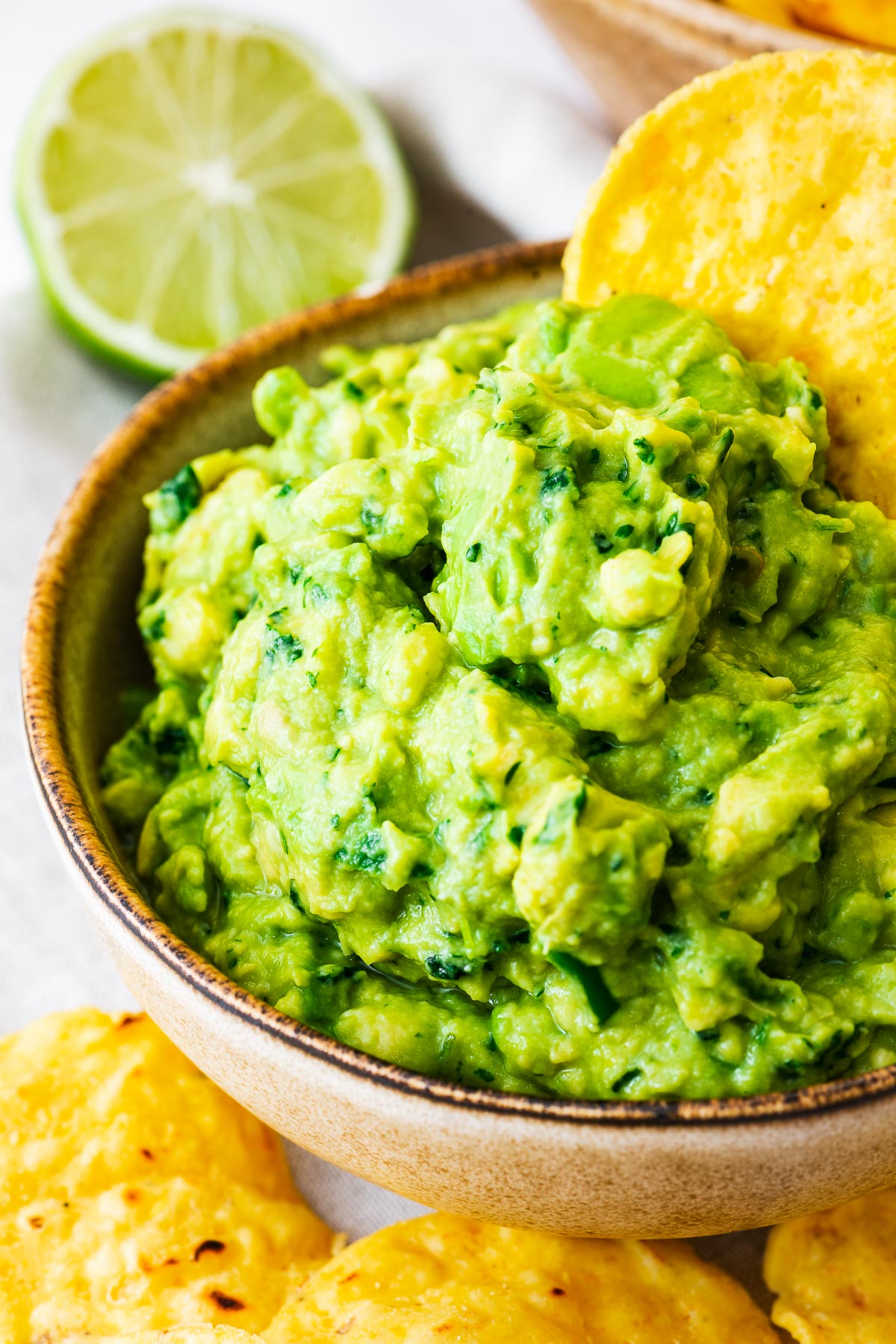
Keep reading to discover all the tips and tricks to keep your gorgeous guacamole green. Or jump to the section that answers your most pressing avocado question.
- Why does guacamole turn brown?
- Is brown guacamole bad for you?
- Comparison of storage methods
- The best way to store guacamole in the fridge
- How long does guacamole last in the fridge
- How to spot bad guacamole
- Extra tips to extend the shelf life of guacamole
- Can you freeze guacamole?
- Do avocado pits prevent guacamole from turning brown?
Why does guacamole turn brown?
Avocado flesh contains polyphenol oxidase, an enzyme that reacts with oxygen. As soon as you slice an avocado and expose the flesh to oxygen in the air, it starts to brown. This process is called oxidation.
Guacamole reacts in the same way. The top layer of guacamole in contact with oxygen develops an unappetising brown colour.
Luckily, the reaction is only visual. The flavour and nutritional benefits remain unchanged. And while we can’t stop it completely, we can deter guacamole from going all-out brown and keep it fresher for longer.
Is brown guacamole bad for you?
Brown guacamole has an unappetising colour, but it doesn’t mean it’s unsafe to eat.
As long as you refrigerate the guacamole and it is no more than three days old, Food Network’s nutritionist Dana Angelo White confirms that while a bit off-putting to look at, brown guacamole is totally safe.
The same goes for brown avocado.
We can delay or limit the browning process with a few kitchen hacks, but nothing will completely prevent the oxidation.
Let’s compare four popular methods for storing fresh guacamole with a simple, not-very-sciency kitchen experiment.
Comparison of storage methods
I made a large batch of guacamole without onion or tomato, unintentionally ate half of it (as one does) and refrigerated the rest.
You may ask, why no onions? But guacamole prepared without watery ingredients like onions or tomatoes lasts better in the fridge and the freezer.
I placed 150 grams of guacamole into four small airtight containers, tapping them on the counter a few times to disperse air bubbles.
For the control guacamole, I left it as is. The second got a layer of water. The third received a double layer of cling wrap and the fourth a squeeze of lime juice.
All the samples remained in the fridge for three days.
Related post: I used this easy guacamole recipe without onion or tomato to test the different methods of delaying browning.
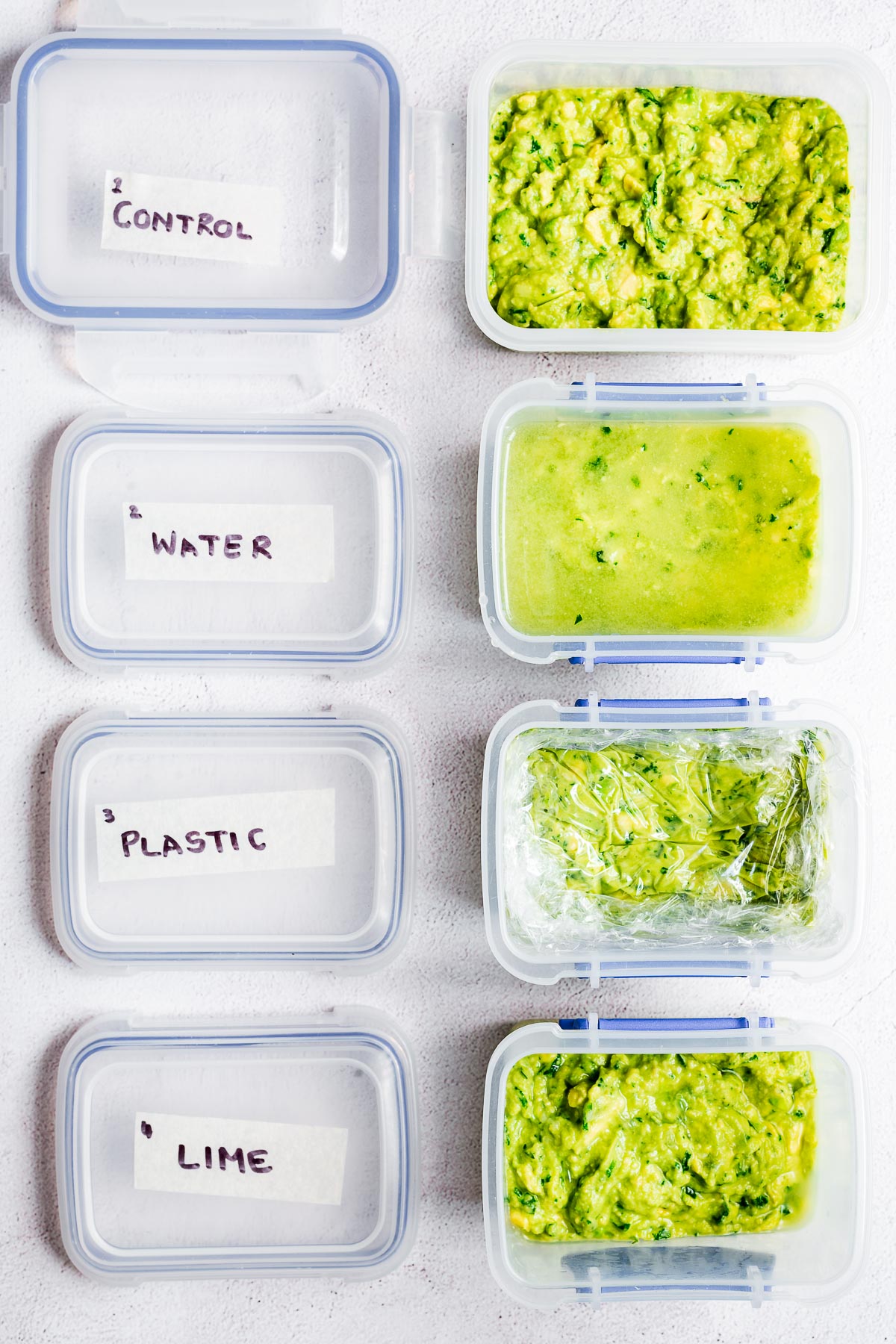
1. Guacamole in an airtight container
While the guacamole is in an airtight container, there is still significant oxygen exposure. The top layer of the guacamole turned brown within a day.
And the depth of the brown layer was, as expected, the worst of the four samples.
A reusable silicone freezer or Ziploc bag is a better bet to limit oxygen exposure.
2. Guacamole with water
I poured about three tablespoons of water over the smoothed surface of the guacamole. And I was very sceptical of this method at first.
But water is the perfect barrier against oxidation. And a little water does not affect the texture or the flavour. While citrus juice works well to preserve the colour, it throws off my lovingly crafted perfect avo-to-lime ratio.
3. Guacamole with plastic wrap
I used a double layer of plastic wrap to cover the chunky mashed avocado because cling wrap is still somewhat permeable.
This method had less browning than the control guacamole, but still a significant amount.
And it has the obvious drawback of requiring single-use plastic.
4. Guacamole with lime juice
Citrus juice, like lime or lemon juice, contains ascorbic acid that combats the enzyme responsible for the browning process.
I rubbed the inside of the container with juicy lime flesh before scooping the guacamole into the container. With just a small squeeze of lime juice over the top of the guacamole, the green colour of the guacamole improved drastically.
However, the resulting avocado dip is now overly tart.
Keep in mind that the effect will be less prominent with large portions of guacamole in deep containers. But still, my guacamole avo-to-lime ratio is a precision game.
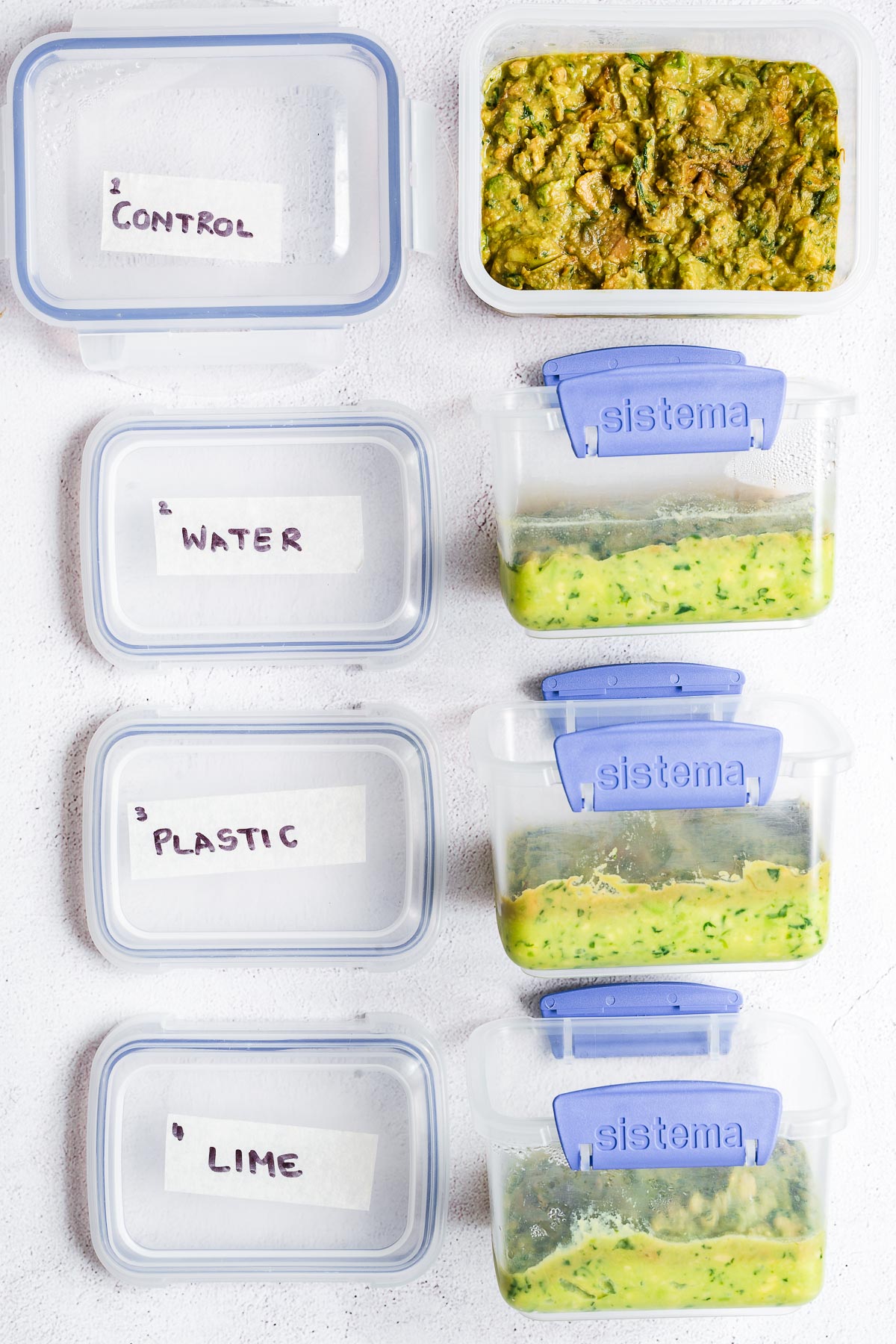
The verdict
The guacamole with lime juice and the one with water did best to limit browning. The top layer colour of the guacamole with lime juice was slightly more vibrant, but the depth of the brown guac layer was shallower on the guacamole stored with water.
And because water is significantly cheaper than fresh limes, it is the clear winner in my books.
But if you have some spent limes, you can certainly rub your container with them. Or try to get the last drop of lime juice out and sprinkle it over your smoothed guacamole surface.
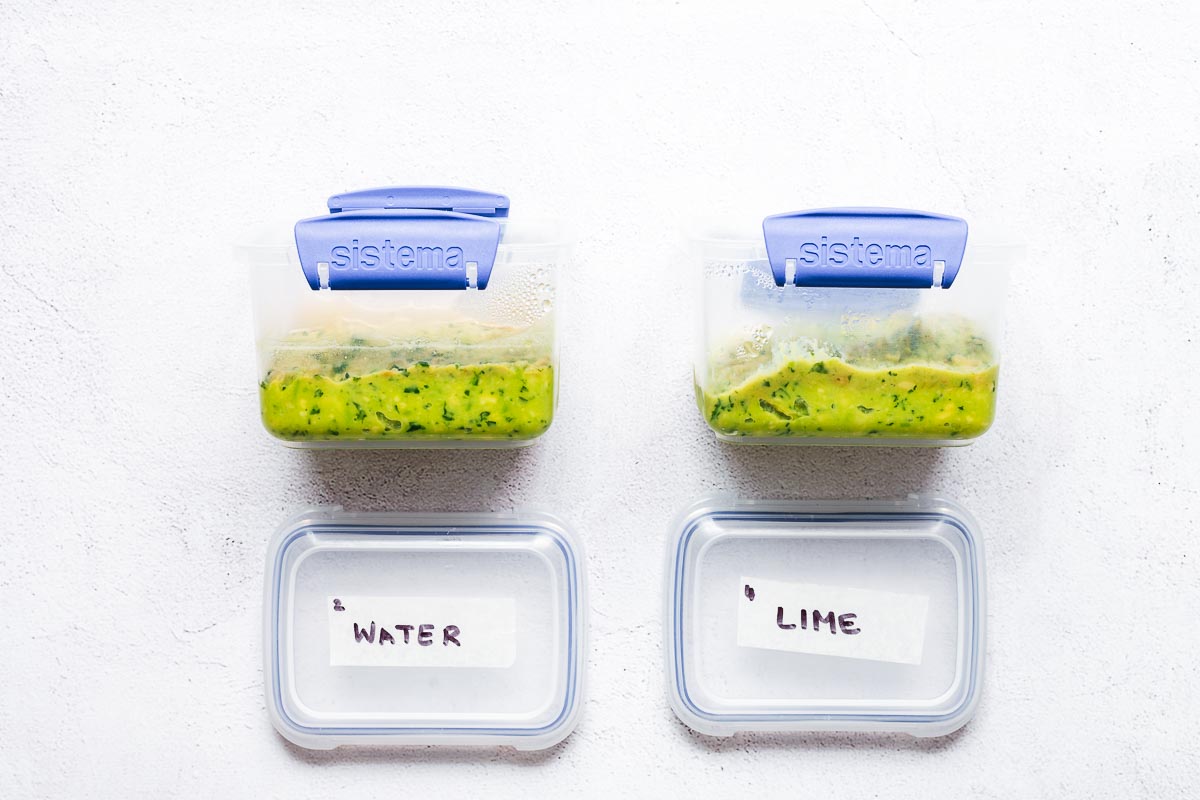
The best way to store guacamole in the fridge
Store homemade guacamole or open store-bought guacamole in the fridge for up to three days. Preserve the gorgeous green guacamole colour by adding a layer of water over the top of the guacamole.
Step 1: Pack the guacamole tightly
Scoop the guacamole into an airtight container. Use the back of the spoon to really squeeze it into the corners to eliminate air pockets.
Step 2: Smooth the surface
With the back of your spoon, smooth out the guacamole surface to get rid of all the nooks and crannies. It ensures proper coverage with less water.
Step 3: Gently pour water
Cover the guacamole in a layer of water about one inch deep (2.5 cm). Pour the water over the back of a spoon or slowly drizzle down the side of your measuring cup to not disturb the smooth layer of guacamole.
Step 4: Refrigerate
Seal your container and refrigerate the guacamole for up to three days.
Step 5: Enjoy
Open your container and pour off the layer of water. Stir your guacamole with a fork to gently incorporate any leftover moisture.
How long does guacamole last in the fridge?
You can refrigerate fresh guacamole for three days if you store it properly. Limit exposure to oxygen by covering your guacamole with a thin layer of water. It will allow the guac to retain its gorgeous green colour.
Unopened store-bought guacamole can last longer due to the addition of preservatives and stabilisers. Always check the label on your guacamole for its storage instructions and expiry date. Once opened, make sure to use your store-bought guac within three days.
How to spot bad guacamole
So, we already know that brown guacamole may still be edible. But how do we tell when the guacamole is actually off?
If your guacamole is older than three days, it’s time to toss it.
Other signs that you should discard your guacamole:
- There are mouldy or fuzzy spots on the guacamole. Don’t be tempted to scoop off any yucky bits. Discard all of it.
- It smells funny. If your guacamole has a funky fermented smell, it’s time to chuck it. It should still have a sweet, fresh avocado aroma.
- It tastes off. If your guacamole has an unpleasant sour or rancid taste, spit it out and toss the rest. Only attempt a taste test if your guac passed the first two signs of spoilage, AND it is no older than three days (having been properly refrigerated all of the time).
It’s one of those better safe than sorry situations. When in doubt, throw it out.
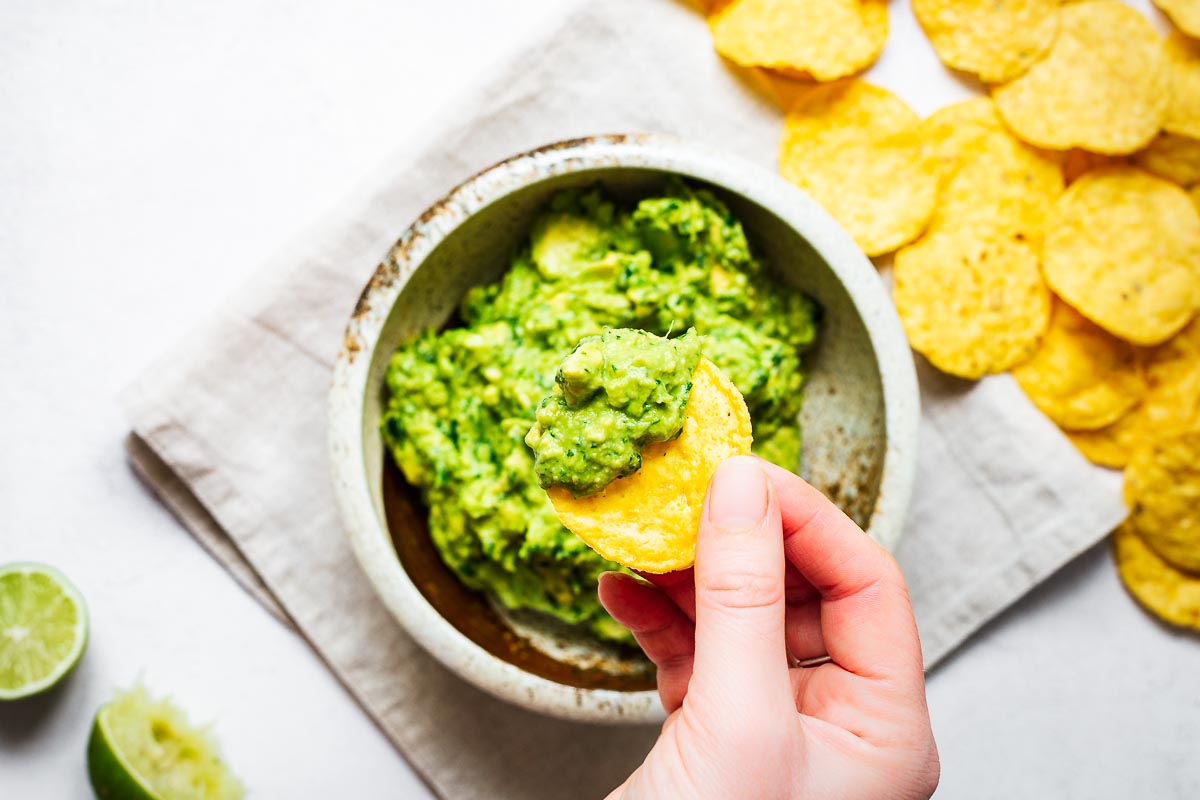
Extra tips to extend the shelf life of guacamole
Unfortunately, bacteria growth does not always leave visible clues.
With a few kitchen tips, you can be sure that your guacamole stays fresh and safe to enjoy.
Whenever outbreaks of foodborne illness occur with restaurant food, hygiene, or lack of it, was a big issue. So always ensure that your kitchen, equipment, ingredients, and hands are clean.
1. Wash your avocadoes before you slice into them
Contamination with bacteria, such as e. coli and salmonella, can occur on the skin of the avocado. And when you slice through the skin with a knife, it is possible to spread the bacteria to the edible avocado flesh.
2. Wash your hands
Always keep your hands clean when working with food to keep bacteria spread at bay.
3. Avoid cross-contamination
Guacamole consists of raw fresh ingredients. Take care not to contaminate your work surfaces, cutting boards and knives with meat or unwashed vegetables.
Keep in mind that while meat dishes get cooked, possibly killing the bacteria that cause foodborne illnesses, guacamole is served completely raw.
4. Store in clean containers
Always make sure your airtight containers are squeaky clean.
5. Refrigerate immediately
Don’t leave that bowl of guacamole hanging around on the table after everyone stops snacking.
Not only can guacamole go off, but it can also spread foodborne illness when not kept cold. Contaminating microbes thrive in warmer temperatures.
Can you freeze guacamole?
Yes, you can freeze guacamole. Place your mashed avocado in freezer bags. And squeeze out as much air as possible. Freeze it immediately.
For small portions of guacamole, you can freeze it in an ice cube tray.
Mashed avocado without high water content ingredients like onions and tomatoes is best for freezing.
Try this recipe for basic guacamole without onion or tomatoes.
Never freeze old mashed avocado or any guacamole that spent more than two hours at room temperature. Freezing guacamole won’t kill harmful bacteria that develop at room temperature.
Learn the correct way to freeze guacamole (+ the best guacamole recipe for freezing).
Do avocado pits prevent guacamole from turning brown?
No, adding an avocado pit to your guacamole or avocado salad will not keep avocados from turning brown. The browning is from oxidation, and the avocado pit does nothing to delay oxidation other than cover a small piece of the surface.
Harold McGee documented his side-by-side mashed avocado experiment in The Curious Cook.
One bowl of fresh avocado mash had an avocado pit, and the other had a pit-sized light bulb. Both browned at the same rate.
Summary: How long does guacamole last
If you store homemade guacamole properly, it lasts in the fridge for three days.
The best way to refrigerate guacamole is to pack it tightly into an airtight container, smooth the guacamole surface with the back of a spoon, and gently cover it with a thin layer of water.
Or top it with a squeeze of lime juice if you are not worried about an overly tart avocado dip.
You can also freeze guacamole for up to three months. And guacamole without onion or tomato stands up to long-term storage the best.
If you love avocados as much as I do, you may be interested in:
- Easy guacamole without onion or tomato
- Avocado green goddess dressing (a great recipe to use up leftover guacamole)
- Kale, quinoa, chickpea and avocado salad
- How to freeze guacamole (+ best loaded guacamole recipe)
